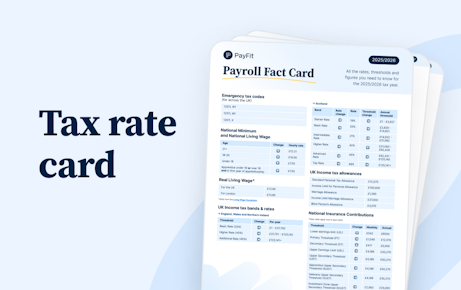How to Calculate Statutory Sick Pay in 2025/2026


The Statutory Sick Pay Rate (SSP) recently got a boost for the 2025/2026 tax year. Here’s everything you need to know about the SSP rate and how it’s calculated for employees.
We’re all human. And that means, from time to time, that we can get sick.
The same goes for your employees. If a staff member’s illness means they can’t come in to work, that employee might be eligible, by law, to receive sick pay in the UK.
But what is paid sick leave in the UK, and how much time (and money) are employees entitled to? Perhaps more pressingly, how can you calculate SSP for your staff?
This guide provides answers to these questions and more. So, let’s dig in.
What is the Statutory Sick Pay rate?
Statutory Sick Pay (or SSP as it’s referred to) is the basic amount of pay a UK employee is entitled to when they’re absent from work due to illness or sickness.
Be careful not to confuse SSP with Occupational Sick Pay (OSP). While SSP is a basic right for every UK employee, it’s entirely up to you as an employer if you’d also like to offer OSP. That said, we recommend that you set up an OSP scheme, as it’s generally a good idea to have one.
What are the current SSP rates in the UK for 2025/2026?
Put simply, how much SSP an employee gets in the UK depends on the number of ‘qualifying’ days they’ve worked each week. Let’s break this down: when someone is sick, their first three days of absence are known as “waiting days”. In other words, they don’t count toward SSP. After that, SSP is payable for every working day (known as qualifying days) that an employee misses due to sickness after the waiting days. From this, you can work out their daily SSP rate.
SSP rates for the 2025/26 tax year are as follows, by the way:
| Daily rates (unrounded) | Number of qualifying days in week |
|---|---|
| £16.9642 | 7 |
| £19.7916 | 6 |
| £23.75 | 5 |
| £29.6875 | 4 |
| £39.58 | 3 |
| £59.37 | 2 |
| £118.75 | 1 |
Remember, as a company, you can decide to pay your employees more than the daily rate of SSP by providing additional occupational sick pay. What you mustn’t do, however, is pay lower than the basic statutory amount; otherwise, you’ll be in breach of legislation.
How much is statutory sick pay per week in the UK?
As you can see from our chart, the standard weekly rate for SSP here in the UK for the 2025/26 tax year is £118.75.
These rates change every tax year, so it’s important to keep on top of them so you don’t accidentally keep paying employees an old rate (if you’re using a platform like PayFit to run your payroll, then you don’t have to worry since rates like SSP automatically update each year).
Who is eligible for Statutory Sick Pay?
Not every UK employee who falls sick will be entitled to sick pay. In order to be eligible to receive the SSP rate, they’ll need to meet certain criteria.
Here are the conditions that would make an employee eligible for Statutory Sick Pay in the UK:
They must have an employment contract with your company (or, in other words, be recognised as an employee);
They must have started working under the conditions of their employment contract;
They must have been sick for four or more consecutive days (known as a Period of Incapacity for Work), including non-working days like weekends;
Their income must not be less than the Lower Earning Limit (LEL), which is £123 per week for 2024/2025;
They must notify you (and, in some cases, show proof) that they’ve been absent from work due to sickness.
In order to consider an employee’s periods of absence as “linked”, the sickness periods must either last four or more days or be at most eight weeks apart.

Who isn’t eligible for Statutory Sick Pay?
An employee isn’t entitled to SSP in the UK if:
They’ve already received SSP for up to 28 weeks;
They’re receiving Statutory Maternity Pay or Allowance;
They’re pregnant and off work for any illness related to their pregnancy within four weeks before the week their baby is due;
They spent the first day of their illness in custody or involved in a strike;
They’re not paying National Insurance contributions because they work outside the EU;
They already received Employment and Support Allowance within their first 12 weeks of working for you.
You’ll need to give employees who are not eligible for SSP an SSP1 Form. Employees can use this form to support their application for Universal Credit and Employment and Support Allowance.
How to calculate the UK SSP rate for your employees
You can calculate the SSP rate for your employees in two ways: manually or by using payroll software.
The formula for the manual calculation of SSP is:
SSP rate formula
Weekly SSP rate ÷ Number of days an employee typically works in a week x (working days worker is ill – 3)
Example: an SSP calculation for a full-time worker
Mina works every Monday to Friday but was absent from work for two weeks due to illness. This means she was unavailable for 10 working days, 7 of which are qualifying (10 days off - 3 waiting days).
To calculate her SSP, you need to divide the weekly SSP rate (£118.75) by the number of days Mina typically works in a week (that’s 5 days). Then, multiply the result by the number of qualifying days (the 7 we got from above). Here’s what that looks like:
£118.75 ÷ 5 days typically worked in week x 7 qualifying days = £ 166.25
Example: how to calculate SSP for a part-time worker
So, what if the employee misses two weeks but only works part of the week?
Let’s say Michael only works Mondays, Wednesdays, and Fridays. In this case, the number of days Michael typically works in a week is 3. So the total number of days worked would be 6. Taking away the 3 waiting days would leave 3 qualifying days for sick leave (6 days off - 3 waiting days). So, the SSP calculation would look like this:
£118.75 ÷ 3 days typically worked in week x 3 qualifying days = £ 118.75
Using PayFit to handle and calculate SSP
Remember when we mentioned there were two ways to calculate SSP - one being manual and the other using software?
The latter is the more convenient way to calculate SSP in the UK and can save your team oodles of time normally wasted on painstaking manual calculations.
Plus, payroll software like PayFit automatically tracks and applies changes to SSP rates to your payroll system.
You can also use PayFit to calculate your employee's Statutory Sick Pay and Sickness deductions automatically when you indicate that an employee is on sick leave. Now that’s pretty handy.
Statutory Sick Pay - Frequently Asked Questions
Yes, it’s the law. As long as your employee meets the eligibility criteria, then as an employer, you have to pay them sick pay.
SSP resets after 56 calendar days. That means that if there’s a period of sick pay within 56 days, then it's linked. You can have up to 28 weeks of linked sicknesses in one period. After 56 days, this 28 week allowance resets.
Yes, employees can use their paid holiday while on sick leave, depending on the circumstances. For instance:
If the employee isn’t physically able to work but can physically still take a holiday
They’re experiencing a mental health condition that might be improved by taking a holiday
Are off sick long-term and a holiday may be helpful to their recovery
If this type of request is approved, then their sick leave should be paused while your employee enjoys their holiday. For these days, normal holiday pay would apply. After this, the employee can either return to work or resume their sick leave if they’re still not well enough to come back to work.
If an employee is off on long-term sick leave and is therefore unable to use their full holiday allowance for that year, then they can carry some of this over into the following holiday year.







